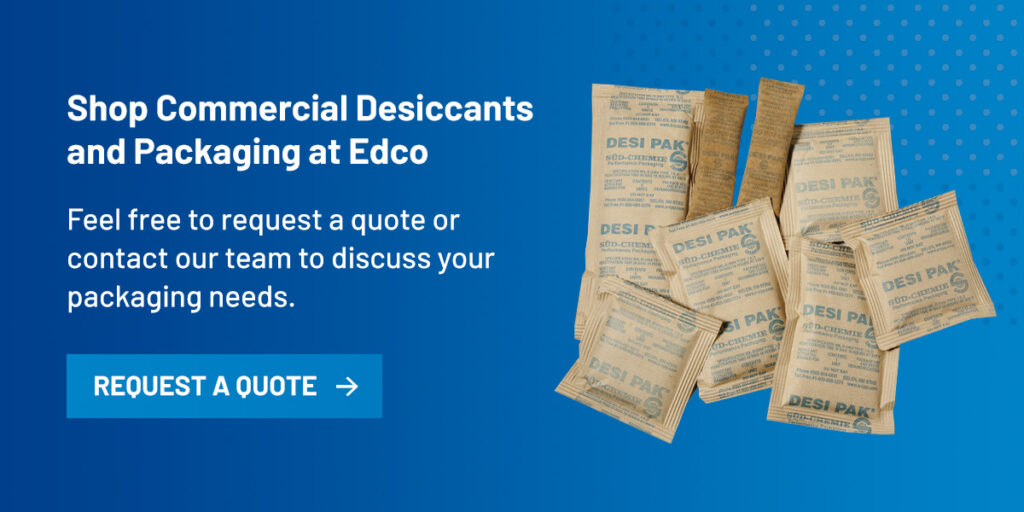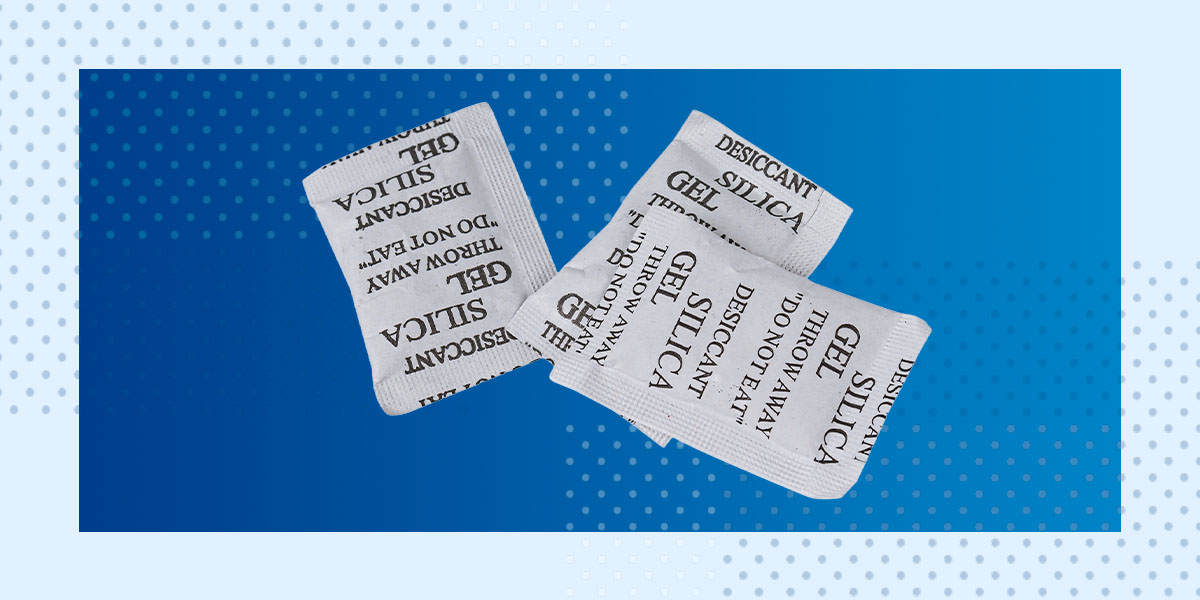Silica gel became a vital component of gas masks in World War I, at which point the protective qualities of desiccants opened up many new possibilities. During World War II, they protected lifesaving penicillin and military equipment. Today, the applications of desiccant protective packaging range from prolonging the viability of military ammunition to preserving eye creams. There’s a universal need for desiccants, as they sustain products and livelihoods in many industries.
Understanding Desiccants
Desiccants are hygroscopic substances that can adsorb and absorb moisture from their environment. Hygroscopic materials are typically supplied with various items to reduce moisture absorption of the protected product.
There are two major different types of desiccants — physical and chemical.
Physical desiccation is the most common method. In this form, the desiccants have a porous surface that absorbs moisture directly by acting like a magnet for moisture in the air. The humidity sticks to the desiccant but doesn’t penetrate it. Chemical desiccation involves using chemicals to remove moisture.
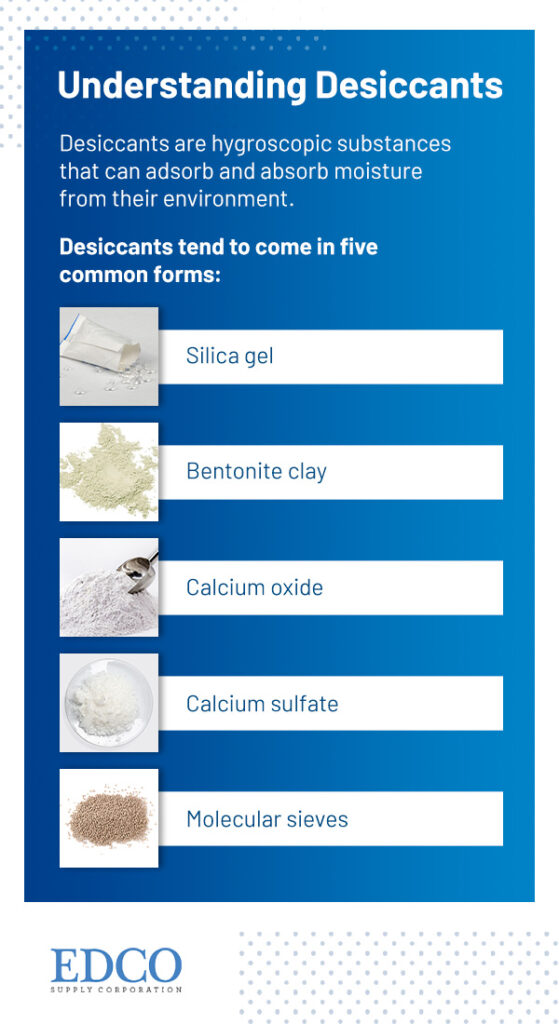
Desiccants tend to come in five common forms that are typically found in everything from medication bottles to beauty products:
- Silica gel
- Bentonite clay
- Calcium oxide
- Calcium sulfate
- Molecular sieves
How Desiccants Work
Desiccants remove humidity in the air through a process called adsorption, which is a surface process that transfers molecules from bulk fluids to a solid surface. Both physical and chemical desiccants work by first triggering adsorption.
Once the moisture is adsorbed, the desiccant absorbs it, meaning it attaches to it and dissolves it on a solid surface. This process allows the desiccant to use its porous surface to trap the moisture so the product it’s protecting won’t be damaged or start to corrode.
The Importance of Desiccant Protective Packaging
Desiccant packs protect various products from moisture and its effects. Excess water buildup can trigger microbial growth, which could cause product spoilage and promote the spread of dangerous bacteria. Humidity buildup can also affect some products’ functionality and cause corrosion.
Desiccants are substances that draw moisture from their surroundings and maintain a dry environment. They are most commonly used for products that can become damaged or corroded if exposed to humidity. Protective packaging helps preserve the quality or freshness of items that are particularly susceptible to humidity by reducing the concentration of moisture in the air.
Industry Applications of Desiccant Protective Packaging
Various industries use desiccant bags, from fashion to tech. In these fields, the loss of product quality can incur a huge financial burden, so protecting valuables from moisture is of the utmost importance.
Food and Beverage Industry
In the food and beverage industry, food packaging desiccants keep items fresh, extend shelf life, and preserve the quality and flavor of consumables. Excess moisture can trigger microbial growth in most food products, which could result in food spoilage and the buildup of harmful bacteria.
Most food products also go through an extensive supply chain from preparing to cooking and freezing. During each step, workers are meticulous in ensuring precise moisture control and appropriate hygiene measures, so it’s essential to maintain those regulatory standards during shipping and storage. That’s where desiccants reign supreme.
When food items are exposed to air or humidity, they start to build bacteria, which could result in mold formation. Some common molds found in foods without proper moisture control include:
- Botrytis
- Fusarium
- Rhizopus
- Neurospora
- Aspergillus
While most food molds don’t cause severe reactions, some types produce mycotoxins, which can induce severe illness, respiratory problems and allergic reactions.
Desiccants also promote food enjoyment by keeping it fresh and flavorful. They absorb excess moisture in crisps, keeping them light and crunchy. They prevent powdered products from sticking together and keep salt and sugar grains separated.
Beverage packaging desiccants prevent mold buildup and harmful bacteria buildup without compromising the quality of the drinks or their packaging.
Pharmaceuticals and Healthcare
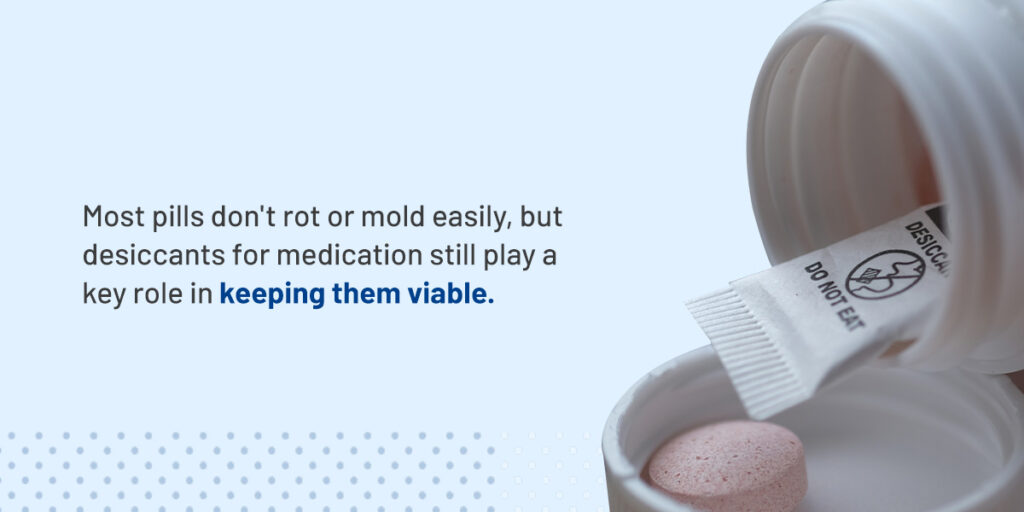
Most pills don’t rot or mold easily, but desiccants for medication still play a key role in keeping them viable.
Along with inhibiting the development of microorganisms, desiccants are commonly used to control the level of humidity in pharmaceutical packaging. Pharmaceutical drugs are often highly moisture-sensitive, and changes in humidity can affect their efficiency and stability.
Without proper moisture management, tablets, capsules and powders may cake, which affects their smooth appearance and makes them hard to sell. Excess humidity can also trigger the degradation of certain ingredients, which could result in loss of potency and potentially detrimental effects on patients requiring a specific dosage.
Pharmaceutical desiccants are of utmost importance because unlike food products, where you can typically see or smell if an item has begun to decay, medicines are hard to identify as spoiled by sight or odor, especially if they’re in a blister pack.
Medical Tools and Implants
With most medicines, the worst that can happen to pills exposed to humidity is lower efficacy or, in rare cases, mold. However, with medical tools and implants, desiccants play a pivotal role in preventing illness and ensuring patient safety.
Medical devices may not function correctly when exposed to high humidity. While there are some exceptions, most products require a cold, dry environment to maintain optimal function. If a tool such as a testing kit malfunctions, it could result in a misdiagnosis, which has negative effects on patient health and safety.
Implants are also susceptible to moisture damage, especially those with bioactive coatings, as they contain active ingredients like antibiotics and growth factors required for patient healing. Pharmaceutical desiccants prevent them from losing efficacy.
Electronics and Technology
Electronic items have a circuit board that’s extremely sensitive to moisture. These circuits are crucial to the device’s functioning, as they hold its memory, send electronic signals and connect various electrical components.
One of the major uses of desiccants in industrial applications is to protect electronics and technology from malfunctioning. Excess humidity can get into the internal components of electric devices and destroy the circuitry. It causes damage to these devices, and the results may not manifest until the customer starts using the products, which could lead to additional costs for companies. Here are the common ways humidity can sneak into electronics:
- The materials are already covered in moisture and then packaged
- The moisture in the air gets into the container
- The water vapor builds up in the box
- Moisture from an external source leaks into the container
If moisture makes its way into an enclosed technological device, such as a cellphone, the humidity, combined with the closed cover, creates steam, which travels through the circuit board and damages it. What makes it more challenging is that the circuit cards tend to be made of plastic, which has a tendency to attract humidity.
Using desiccants for electronic components helps keep them dry during shipping and protects them from absorbing humidity during storage, drastically extending their shelf life. Desiccants also protect sensitive devices like smartphones and cameras, which can easily be destroyed by small amounts of moisture. When a manufacturer packages circuit boards and semiconductors, they attach desiccants to the packaging to absorb moisture before it trickles down into the delicate circuits.
Textiles and Clothing
In the textile industry, products risk being exposed to high humidity through every stage, from manufacturing to shipping. Moisture management during storage and shipping is of utmost importance to preserve the look and feel of items.
Textile desiccants prevent fabric shrinkage, which could drastically affect customer satisfaction. All common fabrics, including wool, synthetic fibers and cotton, require adequate humidity control to maintain softness, stretch and appearance.
Certain fabrics have a high susceptibility to moisture, which can make transporting them especially tricky — a few silica packets are rarely enough to protect a large shipment of clothing. Since most textiles and clothing items are shipped, condensation, cargo sweating and rain are the biggest enemies.
Handling Moisture in Textile Shipping
One way around this risk is to attach an appropriate amount of silica gel desiccant to the seal of the packaging. This step protects the item at its weakest point — the opening. It keeps the packaging moisture-proof and prevents humidity from seeping through and reaching the item.
It’s also crucial to perform moisture testing prior to shipment to ensure the fabric isn’t already accumulating excessive moisture, which could result in a moldy shipment. If the moisture content is too high, it might be a good idea to delay the shipment.
However, if delay isn’t an option, pack the textiles in moisture-resistant packaging and use desiccants for clothing like silica gel. These packets adsorb and absorb moisture and reduce the chances of mold development. Of course, it’s also possible to apply moisture management finishes to prevent humidity absorption and boost the longevity of the product so the consumer can use it longer, but these finishes can add an unnecessary cost factor to some products, making desiccants a more affordable route.
Industrial and Automotive
In the absence of automotive desiccants, excess moisture levels can have a dire effect on automotive and industrial products. The top three issues experts see in this field are:
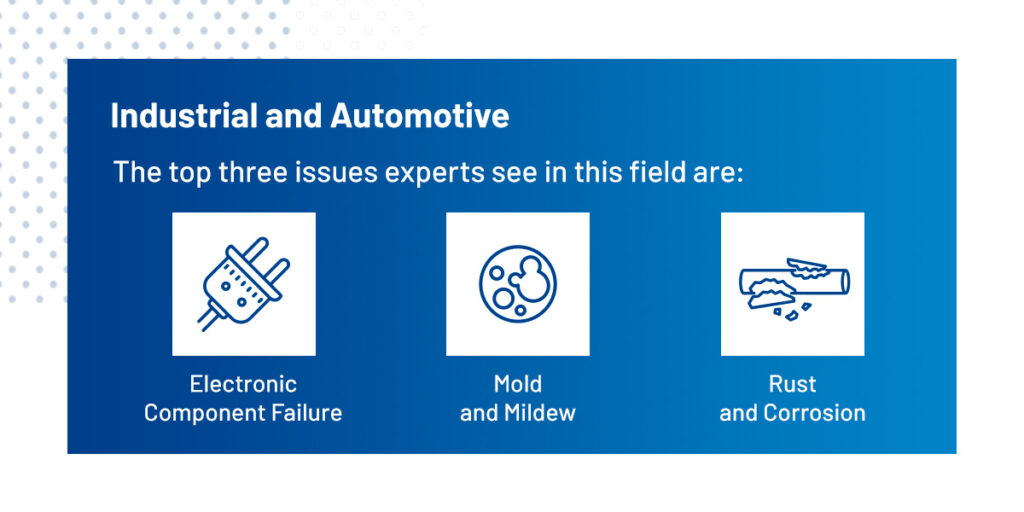
Electronic Component Failure
Most vehicles rely on automated electronic systems to function. Excess moisture can seep through the sensitive components, causing short circuits that could result in dangerous malfunctions.
Mold and Mildew
High humidity can create the perfect breeding ground for mold and mildew, which could affect the driver and passengers of the vehicle. Young children, allergy sufferers and older passengers are particularly vulnerable to health concerns caused by these microorganisms.
Rust and Corrosion
Although uncommon, metal parts do rust and corrode over extended periods in humid environments, which poses a problem for vehicle storage. Rust in critical components like braking systems can cause accidents and create potential legal problems for automotive companies.
Typical moisture control solutions in this field include:
- Silica gel
- Clay desiccants
- Calcium chloride
- Molecular sieves
These industrial desiccants keep automotive and industrial products moisture-free, especially when stored in warehouses that may not be optimized for humidity control. Companies also apply them to shipping containers and packaging materials to prevent possible corrosion during transit and ensure the customer gets a functional, rust-free product.
Cosmetics and Personal Care
In the cosmetics and personal care field, product appearance is everything. Customers want pigmented or perfectly fragranced products, and excess humidity can compromise these qualities. Without humidity control, moisture can seep into makeup products and dull out the pigments, affect the integrity of perfumes and colognes, or alter the texture of lotions and creams. Using desiccants for cosmetics helps prevent moisture-induced spoilage.
Cosmetic products tend to come in metal or plastic packaging, both of which are prone to attracting humidity. Additionally, many beauty items come in powder form and could be completely ruined by excess moisture. One of the main forms of desiccant protective packaging for cosmetics applications is silica gel, as it’s nontoxic, sustainable and formulated to prevent moisture from seeping in and damaging the formulas of these goods.
Silica is also a popular choice because it doesn’t interact with the compounds in the packaging of cosmetic products. It also maintains the product consistency and potency for a longer duration than other options, making it crucial for the storage of cosmetics and skincare items.
Some silica microsphere gels are also used in beauty products because they provide benefits such as the following:
- Smoothing the skin
- Absorbing excess oils and sebum
- Imparting a blurred, matte effect
- Skin exfoliation
Aerospace and Defense
The military and defense industry uses mil-spec desiccants to transport and store medical supplies and equipment, including sensitive aerospace components. These compounds maintain a sterile environment that allows items to last for longer periods, making them ideal for preserving emergency supplies. The military has many important uses for desiccants.
Weapons and Ammunition
One of the most important uses of military-specification desiccants is controlling excess moisture that could lead to the corrosion of firearms and ammunition. Firearms can rust when exposed to high humidity over time. Ammunition also deteriorates with moisture exposure, which can result in failure to fire or diminished performance, potentially causing dangerous squib loads.
Desiccant packs absorb large amounts of moisture lingering in the air, helping prevent weapons and ammunition from corroding and deteriorating. These resources are critical for maintaining operational readiness.
Vehicles and Equipment
Mil-spec desiccants are also imperative to the maintenance of military vehicles and equipment, especially those frequently subject to harsh conditions like dust, heat, fog and contamination. Desiccants absorb chemicals, moisture and odors, protecting vehicles and equipment from corrosion or mold and mildew development that could lead to dangerous malfunctions.
Desiccants also contribute to keeping stored equipment usable, which is invaluable for operations that have to rely on preserved resources.
Medical Supplies and Food Rations
Medical supplies and food products must be sterile to prevent contamination from bacteria and other harmful pathogens. Desiccants maintain a dry environment that prevents mold growth on food and medical supplies and prolongs their shelf life for long journeys, extended storage times and prolonged military operations.
Shop Commercial Desiccants and Packaging at Edco
Desiccants are essential for protecting products from mold, mildew, corrosion and moisture damage. Edco Supply Corporation offers a range of desiccant drying packets and packaging solutions for various industries. We are the world’s leading supplier of military-specification packaging, providing Type I and II desiccant packets as well as moisture barrier protectants.
Feel free to request a quote or contact our team to discuss your packaging needs.
